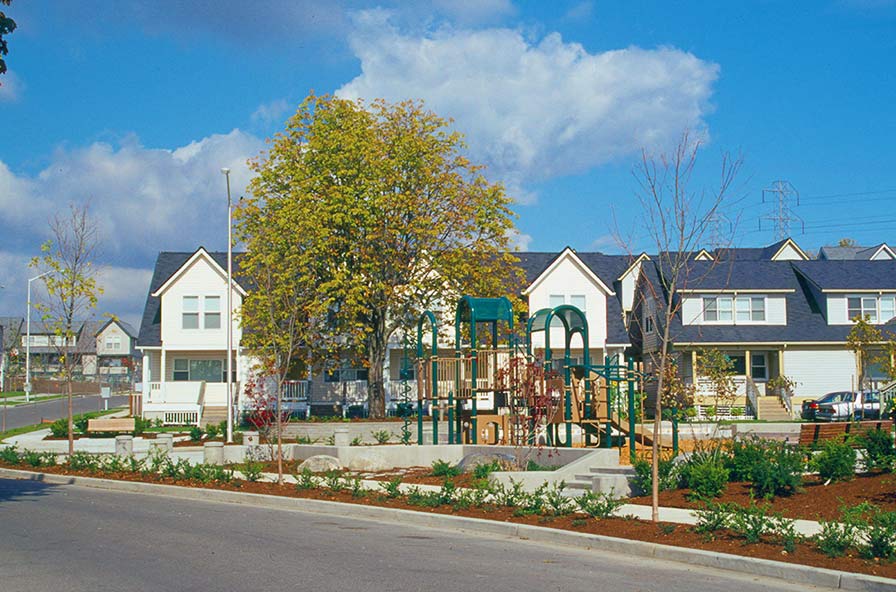Resource Library
Page 3 of 11
The Economic Benefits of Walkable Communities
This fact sheet profiles examples of walkable communities designed to lead to a good climate for the businesses of the New Economy.

October 10, 2013
Shaping the Tools of Re-Invention
Good Citizens, Better Communities By Dave Davis, President, Initiatives A community’s civic infrastructure is just as important as its physical infrastructure. How we involve the men and women, seniors and children, businesses and neighborhoods, in our communities must play a crucial role in how we build our buildings.
July 16, 2013
Neighborhood-Scale Planning Tools to Create Active, Livable Communities
Sprawling urban development and auto-dominated streets make it nearly impossible for people to integrate walking or bicycling into their daily routines. As national physical activity levels decrease and obesity rates increase, local leaders are looking for ways to incorporate smart growth or livable communities principles into their general plans so people can safely and conveniently…
Tags: development, planning, smart growth
September 23, 2013
Livable Communities and Urban Forests
The trees in our parks, yards, public spaces and streetscapes — our “urban forests” — play a vital role in the health and economic vitality of our communities. Trees affect the quality of the air and water where we live, the cost of heating and cooling our homes and businesses, property values, and ultimately, the…
Tags: trees
October 11, 2013
Land Use Planning for Safe Crime-Free Neighborhoods
The design of our neighborhoods, streets, housing developments and parks can dramatically influence the way citizens feel about them and interact in them.
October 10, 2013
Healthy Communities Success Story: Unique Land-Use Solutions and Fiscal Management Strategies in Turlock
With a growth rate triple its historic average, the city of Turlock experienced rapid growth in the late 1980’s and early 1990’s. The City experimented with building permit caps in the early 1990’s to address growth impacts on infrastructure. However, it didn’t want to constrain new housing opportunities or economic stimulus. The City was also…
Tags: health, smart growth
January 27, 2014
Healthy Communities Success Story: Tulare’s Earlimart School District Leverages Kitchen Facilities to Address Food Insecurity
An estimated 57,000 adults in Tulare County experienced food insecurity – the lack of adequate food or income to ensure a balanced diet – during the recent recession, according to a 2012 policy brief by the UCLA Center for Health and Policy Research. The Tulare County food bank currently feeds a quarter of the population…
Tags: food insecurity, success story
Healthy Communities Success Story: Addressing Food Insecurity in Sacramento through Urban Gardening
Food insecurity – the limited or uncertain ability to acquire nutritionally adequate and safe food – is on the rise in Sacramento County. Concentrations of individuals and families who are food-insecure tend to appear in lower-income communities of color. However, incidences of food insecurity are also on the rise in areas perceived as more affluent….
Tags: food insecurity, success story
Healthy Communities Success Story: City Heights Develops Financing Strategy to Improve Walkablity and Grow Small Businesses
Walkable streets form the backbone of healthy, safe neighborhoods. Communities that provide a comfortable walking environment connecting to destinations also experience higher property values, and are attractive to existing and future residents. Download the Fact Sheet: Healthy Communities Success Story: City Heights Develops Financing Strategy to Improve Walkablity and Grow Small Businesses (PDF) This summary…
Tags: street design, success story, walkability
February 21, 2014
Energy and the Human Environment
Toward Better Neighborhood Design By Judy and Michael Corbett Introduction Energy costs are eating up an ever-increasing percentage of the family income today. Home utility bills are doubling and tripling. The price of gasoline for the family car continues to rise. The family budget is impacted both directly and indirectly. Almost every product we use,…
July 16, 2013
Designs and Codes That Reduce Crime Around Multifamily Housing
Research shows that crime rates are influenced by the design of both the building and the space surrounding the building. This 4-page fact sheet (PDF, 232 KB) highlights some of the key design concepts that architects, landscape architects, planners, and elected officials can employ to help ensure that new multifamily housing remains crime-free.
October 11, 2013
Emergency Response and Narrow Streets
For decades wide suburban-style streets have been the norm in new developments. As the Smart Growth movement gained momentum, emergency response agencies, especially fire departments, expressed concern about the narrower streets seen in many Smart Growth developments. Their fears were that these streets would slow down responding vehicles in an emergency situation where seconds are…
November 8, 2013
Development And Public Health
Could our development patterns be affecting our personal health? By Richard E. Killingsworth and Jean Lamming Urban Land, July 2001 A nostalgic view of American cities suggests they were once designed for and accommodated people. In that bygone era, public places, local stores, and transit stops were readily accessible by foot or bike. But then…
July 13, 2013
Designs and Codes That Reduce Crime Around Multifamily Housing
A number of local agencies have converted anti-crime design concepts into local codes and guidelines for new development and redevelopment. The following examples have been implemented by jurisdictions:
August 8, 2013
Community Design Fact Sheets for Safe Streets and Healthy Communities
Calles Seguras Para Peatones (Streets that are Safe for Pedestrians) and Salud y Diseño Urbano (Health and Community Design) are part of a packet that includes the following:
Tags: street design, walkability
September 23, 2013
Building Livable Communities With Transit
By Paul Zykofsky, AICP, Director, LGC Center for Livable Communities Livable communities are hot. In a speech on January 11, 1999, Vice President Gore unveiled the Administration’s Livability Agenda while announcing a wide range of measures to assist state and local governments to plan for smart growth.
July 13, 2013
“Calles Más Seguras para Familias y Niños”
In California and in the Central Valley, a markedly disproportionate number of Latinos are hit and either injured or killed by vehicles while they are walking to work, school, and other routine destinations. Nearly half (49%) of children and youth pedestrian victims in California are Hispanic, according to a report published in October 1997 by…
November 8, 2013
Streets and Sidewalks, People and Cars
This hands-on guide gives citizens the tools they need to evaluate and improve the safety of their neighborhood residential and commercial streets.
Tags: community design, guidebooks, healthy communities, publication, street design and walkability
August 8, 2013
Administration: Who’s Involved
Governor’s Administration Involved in AB-32 Implementation
September 24, 2013
A list of energy efficiency best practices case-studies
These case studies were developed by the Statewide Local Government Energy Efficiency Best Practices Coordinator.
September 19, 2013
Page 3 of 11
